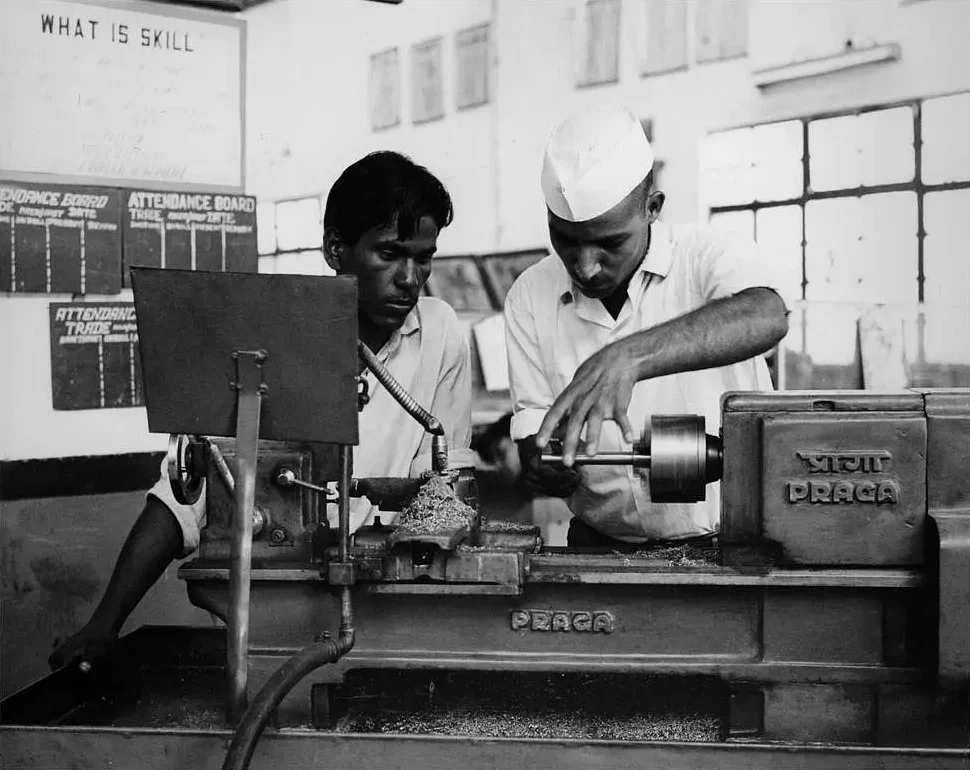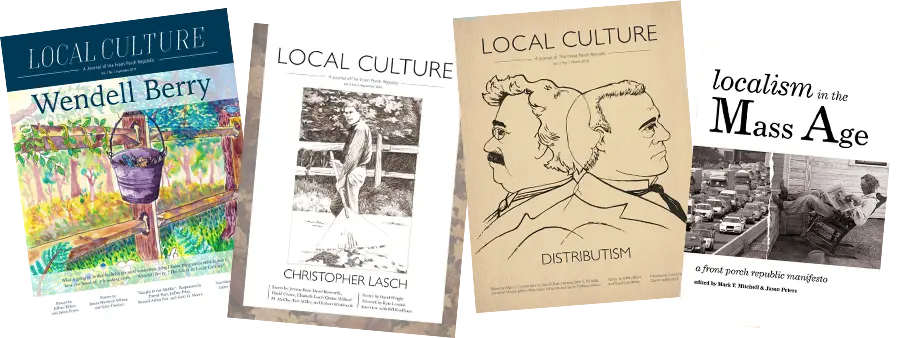What is education for? And by what means can one be educated? To those who do not come from an educational background or have not given these questions much thought, the answers might appear self-evident: “Transferring information” and “by teachers and books and lectures and assignments.” While somewhat true, these replies are woefully reductionistic. Of course philosophical debates, spanning anthropological, political, social, economic, theological, methodological, and moral lines of reasoning, have raged across centuries—indeed, millennia—in search of satisfactory responses, and to this day there is not anything close to an accepted consensus.
American history is replete with stories of educators and their own answers to these questions. Historian and journalist Connie Goddard, in her Learning for Work: How Industrial Education Fostered Democratic Opportunity, tells a handful of them. Some of their names are well known, others less so. John Dewey, Booker T. Washington, W.E.B Du Bois, and Ella Flagg Young might be among the former; Theodore Weld, Charles Ham, Calvin Woodward, and William Valentine among the latter. All of these figures, differing as they did across educational matters great and small, had this much in common: education must consist of the marriage of head and hand.
Why? “The harmonious growth of the whole being,” according to the father of the kindergarten Friedrich Froebel; for Charles Ham, “manual training tends to correct vicious mental impulses,” which is important since “intelligence is the basis of character”; Calvin Woodward wanted to “put the whole boy to school,” head, hand, and heart, and in an 1878 address quoted Thomas Carlyle who said, in Goddard’s words, that “the knowledge of material things was as necessary to the development of the intellect as knowledge of the abstract”; for Dewey, manual training alongside classical education was for equipping “pupils for their life in the community with the hope of improving the community itself.” These and other nineteenth-century pedagogues were all proponents of industrial education.
On my reading of Goddard, she articulates a threefold reason as to why this might be. The American Industrial Revolution seems to have affected at least three domains of human existence deeply enough that it resulted in three unique but related responses, three attempts at reintegrating what had become disintegrated by industrialization. All three involve the application of handcraft as an integral part of their efforts. For the atomized individual, the first domain, there was manual education; for the second, a torn social fabric, there was the so-called new education; finally, as antidote for the tortured industrial aesthetic, there was the Arts and Crafts movement which had begun in England and made its way to American soil. Goddard mentions the influence of the third but focuses on the development of the first and second. Each, if placed on a Venn diagram, would share overlapping ideals, yet each of these movements employed the use of labor toward different ends.
To help us understand those ends, Goddard sets the development of manual or industrial education in the context of Progressive Era Chicago when schools and workplaces were in dynamic relation, both responding to the kind of America the Industrial Revolution was making. Labor was unionizing in an effort to weather volatile market forces; children were leaving school at thirteen and fourteen years old for lack of interest and, in some cases, to take up family or factory work; prisons were filling with inmates whose “industrial fate” (John Dewey’s term) was sealed due to lack of education and employable skills; immigrants from Germany, Poland, China, and Italy flocked to Chicago with the hope of escaping crop failure and joblessness; former craftsmen working small-scale businesses, no longer able to compete with manufacturing plants and factories, became wage-earners. All these factors and more converged on the Windy City, resulting in a decades-long pedagogical experiment that ultimately changed the landscape of American education.
Before we discuss the why of industrial education, it may be helpful to define what it is. The term seems to be used synonymously with some others in Goddard’s text (e.g. manual training, manual education) and she does not ever give a tidy definition. Her use of the term appears to mirror its usage in the source material, which is to say: it meant whatever the individual using it wanted to mean. For some it was economic, other imported humanist ideals, others emphasized pedagogical methods. “Industrial” as a descriptor for “education,” contrary to what might be connoted in conversations around the Industrial Revolution today as it pertains to human flourishing, was meant as a good thing (despite the effects of industrialization already mentioned). So what is it? Industrial education combined the acquisition of manual skills alongside classical education (which was the ideal of the early manual education movement), an emphasis on self-initiative and fitness to the social and economic environment that the student would graduate into (which was the ideal of the new education), and for some it came to include preparation for specific job roles as in modern day technical or vocational training programs.
Even “human flourishing,” an ideal for which I believe industrial educators would have said they were all working, is not a clearly agreed upon concept. Does it come through the integration of an individual’s faculties and growth in virtue? By the cultivation of a sharp mind? By fitting a student to their economic environment? What is education for?
As Goddard says in her essay for FPR, the “argument that the vocational aspects of an education are as valuable as the academic ones has been around at least since the days of Jane Addams and John Dewey.” In her book she makes clear that the answer to the question “why industrial education?” evolved through time within particular schools of thought that prioritized different motivations. And while industrial education found wide support, it was not without its critics and detractors. For the sake of this review I will touch on only a small handful of perspectives, both for and against the various industrial education iterations.
Henry H. Belfield—founding director of the Chicago Manual Training School (CMTS) which opened its doors in 1884 and took for its motto the Latin phrase mente atque manu ad virtutem, through mind and hand to manhood—argued that for too long “education and the knowledge of books [have] been regarded as synonymous; whereas literary culture is only a part of education.” If the end of education is a wholly integrated human being, then full-orbed education would address not only the mind but would also train the body and infuse the hand with skill. Belfield, quoting fellow proponent Calvin Woodward, believed that a classical education “neglects all the powers of some minds, and some of the powers of all minds.” The curriculum he established for CMTS would be half traditional book and classroom instruction, half shop classes and handskill acquisition. Students taught in this way “learn in half-time what others learn in full-time.” “There are but three ways of getting a living,” said Belfield, “by working, by begging, by stealing, and a boy [who] is not educated to support himself by working, is condemned to be a mendicant or a rogue.” (Goddard’s work is the first recorded history of CMTS, which is very worthy of study.)
While Belfield relied on the philosophical and socioeconomic value of the manual arts to bolster his view, another early proponent, Nicholas Murray Butler, argued along a different line of reasoning, taking his cues from research and discoveries in the central nervous system. For Butler, training of the sense-perception—learning through the hands and the eyes—“is mental training of importance equal to what is learned through thought alone” and yet not an end unto itself. Goddard sums up Butler’s perspective thusly: “public schools ought not to be turning out carpenters or cooks, but boys and girls trained to take their own part in life.” Butler made a distinction between the then-new categories of receptive and expressive powers, with classical education indexed to the former and manual training to the latter. “A boy who can draw a three-dimensional cube knows far more about it than one who can merely repeat its definition.” It seems that his primary concern was the development of the individual’s faculties which required training in both receptive and expressive powers, but he also acknowledged that there would be socioeconomic benefits that made these individuals fit to the rapidly developing environment.
His opponent, William Torrey Harris, was not convinced. Harris was eminently concerned with the development of sharp minds that could navigate the complexities and demands of urban society. For him, the school’s “chief role was to guide [students] into control over their impulses; schools’ role was to prepare students for their social role.” Therefore, he saw an emphasis on manual education as flattening the metaphysical hierarchy of mind over matter, ignoring the “great distinction between our higher and lower faculties.” “The preparation of the individual for reciprocal union with society” was the telos of education. While manual education might have some utility toward that end, it is limited at best and therefore not worth much time pedagogically. Harris valued the development of the mind that leads the hand more than the direct development of the hand itself. The physical tail ought not wag the metaphysical dog.
Another who saw a backwards relationship was W.E.B Du Bois. He felt that between industrial education and political rights for Black society, the latter was the more important battle. Du Bois, an incisive and rousing essayist and public intellectual in his time, spent a dozen years at Atlanta University lecturing and writing on the conditions of Black life. He was not opposed to industrial education as such but felt that it limited Black students from exposure to broader democratic culture while training them in outmoded skills. For Du Bois, securing political rights for Black people would allow them participation in that democratic culture, and this came through avenues of higher education. A longtime friend and frequent interlocutor, Tuskegee Institute head Booker T. Washington saw things differently. Washington believed that political rights would follow economic stability, and that economic stability could be achieved through an education that emphasized industrial training. Says Goddard, “For Washington, political rights would follow economic accomplishment; for Du Bois, there would be little of the latter without the former.” Washington was the primary link between Northern money and Southern education opportunities, and his goal was to have every student graduate “with enough skill, coupled with intelligence and moral character, to enable him to make a living for himself and others.” Graduates of Tuskegee, as Goddard shows in her book, seem to indicate that Washington’s goal was not wholly unsuccessful in spite of Du Bois’ hesitance.
Space restricts me from addressing Goddard’s treatment of John Dewey and Ella Flagg Young, two of the biggest players in her book and the industrial education movement at large. I will briefly speak to the latter and let you read Goddard’s book to learn more of the former. Young advocated for, in Goddard’s words, “a reciprocal relationship among [academic] subjects and these connections should be reinforced through practical experience (such as manual work).” “Life, [Young] said, was mostly labor, so children should be guided into activities that would aid them in finding the work for which they are most suited.” As superintendent of schools in Chicago, Young’s aim included young girls, to educate each one “so well that her life would benefit not only her family but her community as well.” She recognized that many women would have to support themselves and so wanted to expand their imaginations for what constituted “women’s work.”
To conclude this section, some saw industrial education as a means to socioeconomic mobility; others as the real-world applications to which they could index traditional academic instruction; others simply as a way of keeping children in school past their early teens and keeping them out of prison as adults; still others as a means for preparing students for particular career paths. It is interesting to note that Karl Marx’s theory of alienation was not invoked at any point either in quotes of industrial educators or by Goddard, although it appears that his fourfold “alienation”—estrangement between workers, their work, their social context, and themselves—could helpfully frame the ailments identified by educators of the time, even if arriving at conclusions different from Marx’s own.
Goddard’s stated purpose for her text was to demonstrate that “these programs provided learning experiences for young people that enriched their opportunities to participate fully in a rapidly industrializing economy.” Her goal, as the subtitle of her book implies, was to show that industrial education did once and can perhaps again foster democratic—that is, accessible to the most amount of the American public—opportunity to participate in the economy. I think she has done a persuasive job. Opportunities that were not available to some due to race, socioeconomic class, or gender became available through industrial education efforts. While some, even many, of the ideals of Charles Ham, Calvin Woodward, and even John Dewey were never fully realized at the scale they had hoped, they did equip Black and white young people of both genders with skills necessary to act as agents in the emerging industrial world.
Goddard posited that past histories written about industrial education have taken the perspective of institutions and policymakers, dismissing industrial education as a “product of Progressive Era condescension toward immigrants and other urban workers.” Historians have not thought kindly of the movement. Rather, she hoped to write a history that drew its conclusions from industrial education as it was experienced by its students and educators and that took its effects into consideration. To my mind, she has accomplished this and paints a fair, if not always pretty, picture of the industrial education efforts.
There is more to say about the book than what has been said. Goddard draws out elements of gender disparity, of race, of both student and teacher preparation. And these are not minor themes: they are necessary to the history she has written because they provide the context in which many of the industrial education leaders’ perspectives were formed and help us understand the ends towards which their efforts were guided. But if a reader wants to see how Goddard weaves these threads, they will be encouraged to purchase and read her work.
I have written for FPR (here, here, and here) about craft and its intersection with theology. The final part of those essays was making my own feeble attempt at answering the questions, “Why are Christian seminaries and experimental schools now requiring manual education? Why are trade schools that meld classical, theological, and manual instruction coming into existence now?” What Goddard has done is helped me notice a pattern that is perhaps obvious to some but has only come into view for me while reflecting on her book: we are once again undergoing a period of rapid industrialization, this time catalyzed in the digital realm. The pandemic was an accelerant. Once more there is new technology that is changing the way we think about work, about skill acquisition, about human flourishing, about how societies function, about culture. Once more certain jobs and skillsets are threatened by extinction at the hands of the Machine. Once more we are attempting to regain what we stand to lose as individual souls and as a society if we become totally subjected to technologies and their technocratic overlords.
It seems, then, that pedagogical experimentation is one natural response to the kind of moment in which we now find ourselves. Thinkers like mid-century British polymath Michael Polanyi, author of The Tacit Dimension, and like electrician, mechanic, and political philosopher Matthew Crawford, author of Shop Class as Soulcraft, have argued convincingly (in the spirit of Nicholas Butler and contrary to William Harris) that careful training of the body and applying it towards some manually laborious end recruits and trains one’s interior world as well, both mind and morals. These arguments are becoming increasingly important as we wrestle with our own growing sense that we’re losing our grip on the real, born of our frictionless digital milieu and the advent of AI, which is integrated more fully day-by-day into nearly every industry and is reshaping our conception of work and thereby our conception of what it means to be human.
Admittedly, I find myself more aligned with Ham, Woodward, Froebel, Carlyle, Butler, Dewey, Polanyi, and Crawford in their vision of “human flourishing.” As it happens, I am an “industrial educator”: a technical instructor for plumbing with my employer, a large home services company. I feel the tension between competing humanist and economic ideals. When I teach, I am hoping to provide a means to a long and fulfilling career for my apprentices (that is what I am paid to do, after all), but I also emphasize the effects of this work on the interior life of the individual and the development of their mental and moral faculties. This latter idea is what has captured my imagination. And I think that these ideals can be accomplished even when they are not made explicit during instruction. Recruiting one’s interior life simply happens when performing skilled labor, and skilled labor is an economically viable career. In the end, I agree with Goddard’s vision of industrial education as providing opportunities in a rapidly changing economy, but I also would not want to lose the focus on the integration of the individual. Industrial education could be seen as capitulating to industrialization, and I suppose in one sense this is the case, but even so we cannot afford to let the integrative element of human flourishing fall by the wayside.
I will end this review with a quote from Goddard’s preface to her book. “Though this is a work of history, it was undertaken out of a conviction that industrial education—now more commonly known as career and technical education—is due for a rejuvenation.” To which I give a hearty, “Amen!”
Image Via: GetArchive




